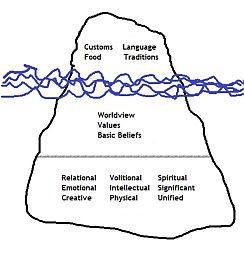You are here: Third Culture Kids > TCK Profile
The Cultural Iceberg

TCKs learn culture the same way all children do—from the world around them. The difference is not in the process but in the world in which they learn culture. In traditional societies, most members of the community share the same values, beliefs, customs, traditions, etc. In the TCKs' world, they are often interacting with many and varied cultural communities either simultaneously or separately as they move from one cultural environment to the other(s).
Historically, the visible elements of culture have been used to both express and identify the invisible layers. In today's world, the visible expressions of culture are becoming more uniform throughout the world but the elements in the invisible layer are much slower to change. The result is more confusion between people because what they expect the person to be when they first meet isn't necessarily how/who the person is.
Culture is learned from those in the surrounding environment including parents, extended family, teachers, peers, caregivers, etc. Culture is what gives us a sense of belonging, identity, and confidence. When we know the rules of the culture, we are seen as an "us" rather than a "them." If you know the rules inside, you can operate with confidence that you will not so easily make a social mistake that might damage a relationship.
For more information: The Identity Model
Permission is granted to copy, but not for commercial use.
